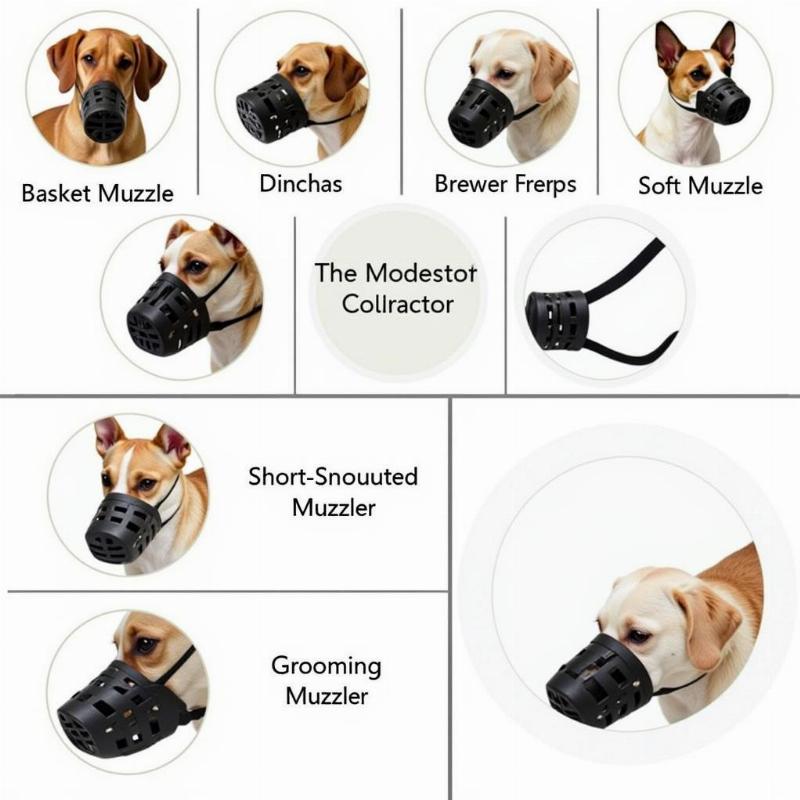A muzzle can be a valuable tool for preventing your dog from scavenging and eating harmful things on walks or even around the house. While some pet owners may initially view muzzles negatively, they can actually enhance your dog’s safety and well-being when used correctly. This article will explore the various reasons for using a muzzle to keep your dog from eating things, different types of muzzles available in the US market, fitting and acclimation techniques, and address common concerns.
Why Use a Muzzle to Prevent Eating?
Several situations warrant the use of a muzzle to prevent a dog from ingesting harmful substances. These include:
- Scavenging: Some dogs have a strong instinct to scavenge and eat anything they find, regardless of whether it’s edible. A muzzle effectively prevents them from picking up and swallowing potentially dangerous items like discarded food, garbage, or toxins.
- Coprophagia (Eating Feces): While unpleasant, coprophagia is relatively common in dogs. A muzzle can prevent this behavior and associated health risks.
- Resource Guarding: Dogs exhibiting resource guarding tendencies may become aggressive when protecting their food or other valued items. A muzzle provides safety for both the dog and others during training and management of this behavior.
- Post-Surgery Recovery: After certain surgeries, a muzzle can prevent a dog from licking or chewing at wounds or sutures, promoting faster healing.
- Medical Conditions: Some medical conditions necessitate dietary restrictions. A muzzle can help ensure adherence to these restrictions.
Types of Muzzles Available in the US
Choosing the right muzzle is crucial for both your dog’s comfort and effectiveness. Here are some common types available in the US:
- Basket Muzzles: These allow for panting, drinking, and even taking small treats, making them a comfortable option for extended wear. They come in various sizes and materials to suit different breeds.
- Soft Muzzles (Fabric Muzzles): These are lightweight and less restrictive, but they don’t allow for panting, so they’re only suitable for short-term use.
- Short-Snouted Dog Muzzles (Brachycephalic Muzzles): Designed specifically for breeds with short noses, these muzzles offer a better fit and allow for adequate airflow.
- Grooming Muzzles: These are typically made of nylon and designed for short periods, primarily for grooming or veterinary procedures.
 Various Types of Dog Muzzles
Various Types of Dog Muzzles
Fitting and Acclimation: Patience is Key
Introducing a muzzle slowly and positively is crucial for your dog’s acceptance. leather collars for small dogs can sometimes be confused with muzzles, so ensure you’re using the correct tool. Here’s a step-by-step guide:
- Positive Association: Start by letting your dog sniff and investigate the muzzle. Reward them with treats and praise.
- Short Introductions: Briefly place the muzzle on your dog’s snout and reward them immediately. Gradually increase the duration.
- Mealtime Muzzle: Feed your dog while wearing the muzzle to create a positive association with mealtime.
- Gradual Integration: Once your dog is comfortable wearing the muzzle for short periods, start using it on walks or in situations where they might be tempted to eat inappropriate items.
- Regular Breaks: During extended wear, provide regular breaks for panting and drinking, especially in warm weather.
Addressing Common Concerns
- Discomfort: A properly fitted basket muzzle should allow for panting, drinking, and even treat-taking. Ensure the muzzle isn’t too tight.
- Stigma: While some may perceive muzzles negatively, prioritize your dog’s safety and well-being. hair raised on back of dog can indicate stress, so monitor your dog for any signs of discomfort.
- Effectiveness: Choose a muzzle appropriate for your dog’s size and breed to ensure it effectively prevents them from eating unwanted items. new orleans saints dog collar might be fashionable, but a muzzle serves a specific safety purpose.
Conclusion
Using a muzzle to prevent your dog from eating things can be a responsible and effective way to ensure their safety and well-being. By choosing the right muzzle type, fitting it properly, and acclimating your dog patiently, you can transform the muzzle into a positive tool that enhances your walks and peace of mind. Remember to prioritize your dog’s comfort and always supervise them while wearing a muzzle.
FAQ
- How do I choose the right muzzle size for my dog? Measure your dog’s snout circumference and length according to the manufacturer’s guidelines.
- Can my dog drink water while wearing a muzzle? Yes, a properly fitted basket muzzle allows for drinking.
- Are muzzles cruel? No, when used correctly, muzzles are a humane way to prevent harmful behaviors.
- How long can my dog wear a muzzle? This depends on the type of muzzle and the weather conditions. Always provide regular breaks.
- What if my dog panics while wearing a muzzle? Remove the muzzle immediately and reassess your acclimation process.
- Can a muzzle help with reactivity? While a muzzle can provide safety, it’s not a solution for reactivity and should be combined with training.
- Where can I buy a dog muzzle in the US? Pet stores, online retailers, and veterinary clinics typically carry a variety of muzzles.
Related Articles
Beautdogs.us is your premier online resource for all things dog-related in the US. We offer expert advice on dog breeds, grooming, health, training, and much more. Whether you’re a seasoned dog owner or just starting your journey, Beautdogs.us is here to help you provide the best possible care for your furry companion. Contact us for personalized support: Email: [email protected], Phone: +1 501-555-7529.